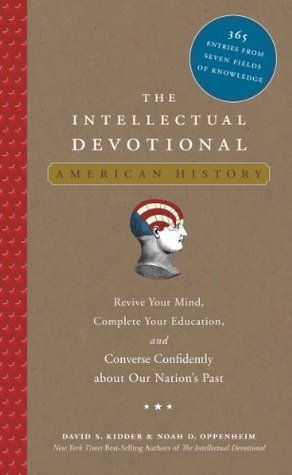More on this book
Kindle Notes & Highlights
Started reading
January 22, 2018
1796 presidential election was the first seriously contested presidential race in American history
In his old age, however, he resumed his friendship with Jefferson. The two men died on the same day, July 4, 1826, exactly fifty years after the adoption of the Declaration of Independence.
Adams entered Harvard at the age of fifteen.
writing a farewell address to the American public.
Washington advised his fellow citizens to avoid any alliances with foreign nations, or even excessive “affection” for them.
Although isolationism still has its supporters, American foreign-policy makers of the post–World War II era have largely abandoned Washington’s recommendations.
Washington’s farewell address was so influential that it is still read aloud every year in Congress.
Second Great Awakening,
period of intense religious fervor in early nineteenthcentury America that energized Protestant churches and helped fuel many important social reform movements, including abolitionism.
Historians point to a camp meeting in Cane Ridge, Kentucky, as the first major event of the Second Great Awakening. Leading Christian ministers from several denominations—including Baptist, Presbyterian, and Methodist—preached to 20,000 people over several days of services. Large-scale, outdoor revival meetings, an incredibly powerful experience for nineteenth-century Americans, quickly spread across the country.
the Second Great Awakening was liberal in both its theology and its outlook, stressing the possibility of Christians earning God’s forgiveness.
In theological terms, the Second Great Awakening asked American Protestants to take an active role in their own salvation.
thirteen-mile railroad connecting the city of Baltimore with neighboring suburbs opened to great fanfare. Initially, the railroad used horses to pull the trains along the line. Later that year, a steam-powered locomotive made its first trip on the railroad, inaugurating the age of steam.
practical for the first time to ship unprecedented amounts of freight and providing a key impetus for the Industrial Revolution.
At the time of the railroad’s opening, Baltimore was the second-largest city in the United States. However, its port was rapidly losing business to New York City, thanks to the success of the Erie Canal.
infamous race between a horse and the first American-built locomotive, Tom Thumb, on the B&
the horse actually won,
first stone of the B&O was laid by Charles Carroll (1737–1832), the last living signer of the Declaration of Independence,
The original B&O route is still operated by the CSX railroad company.
religious revival of the Second Great Awakening, thousands of Americans joined short-lived utopian communities
Oneida community embraced an unorthodox Christian theology; in their case, they believed that the Second Coming of Christ had already occurred in 70 AD, thus making it possible for his followers to achieve perfection on Earth.
Inspired by the transcendentalist movement and European socialism, the founders of Brook Farm sought to create a community whose members would pool their finances, share in the labor needed to run
the farm, and discuss literature around the dinner table.
Noyes was arrested once for adultery and fled to Canada to avoid arrest for statutory rape.
longest-lasting utopian movement of the nineteenth century may have been the Shakers,
Their resilience is somewhat ironic, since one of the religion’s principles is total celibacy.
After Noyes’s death, the Oneida community evolved into a corporation that made the world-famous Oneida silverware.
Uncle Tom’s Cabin, an 1852 novel dramatizing the evils of slavery written by abolitionist Harriet Beecher Stowe (1811–1896), was the best-selling book of the nineteenth century in the United States.
portraying the human consequences of slavery in vivid fashion,
Stowe’s writing often reinforced negative stereotypes of African-Americans.
Stowe intended Tom as a positive example, someone who bore his hardship with Christian grace. But the label Uncle Tom is now often used as an extremely insulting epithet for African-Americans seen as complicit in racism.
After the success of Uncle Tom’s Cabin, Stowe and her husband moved into a big house in Hartford, Connecticut. Their next-door neighbor was author Mark Twain
Most of the novel was written while Stowe lived in Brunswick, Maine, where her husband was a professor at Bowdoin College.
Composer and United States Marine Band conductor John Philip Sousa
During Sousa’s tenure, he turned the Marine Band into the nation’s premier brass band, earning the group the nickname “The President’s Own” that is still used today.
recordings of his performances are extremely rare, since he disdained radio and phonographs and almost never allowed his shows to be recorded.
Sousa invented the sousaphone, a tuba-like instrument that can be carried in a marching band.
Congress declared “Stars and Stripes Forever” the national march of the United States in 1987.
Thomas Jefferson (1743–1826) wrote the Declaration of Independence and acquired the vast Louisiana Territory for the United States.
Jefferson himself did not consider his years in the White House a major accomplishment, and he left the presidency off of his epitaph.
President Thomas Jefferson (1743–1826) waged the first foreign war of the United States in 1804 against gangs of pirates known as corsairs who preyed on American ships in the Mediterranean Sea.
The expedition against the Barbary pirates was the first overseas deployment of the US Marines, inspiring the phrase in the famous opening stanza of the “Marine’s Hymn,” “to the shores of Tripoli.”
The First Amendment to the Constitution, Jefferson argued, had erected a “wall of separation” between church and state that meant Connecticut could not interfere with the Baptists’ religious freedom.
A painter by training, Morse was born in Massachusetts and traveled widely in Europe in pursuing of his artistic career. However, he became fascinated by electricity,
Morse also developed Morse code, the system of dots and dashes used to transmit numbers and letters along telegraph wires.
first message tapped along the line in 1844 was a famous quote from the Bible: “What hath God wrought!”
first words transmitted on the transcontinental telegraph line, which was completed in 1861, were anticlimactic: “Line just completed.”


